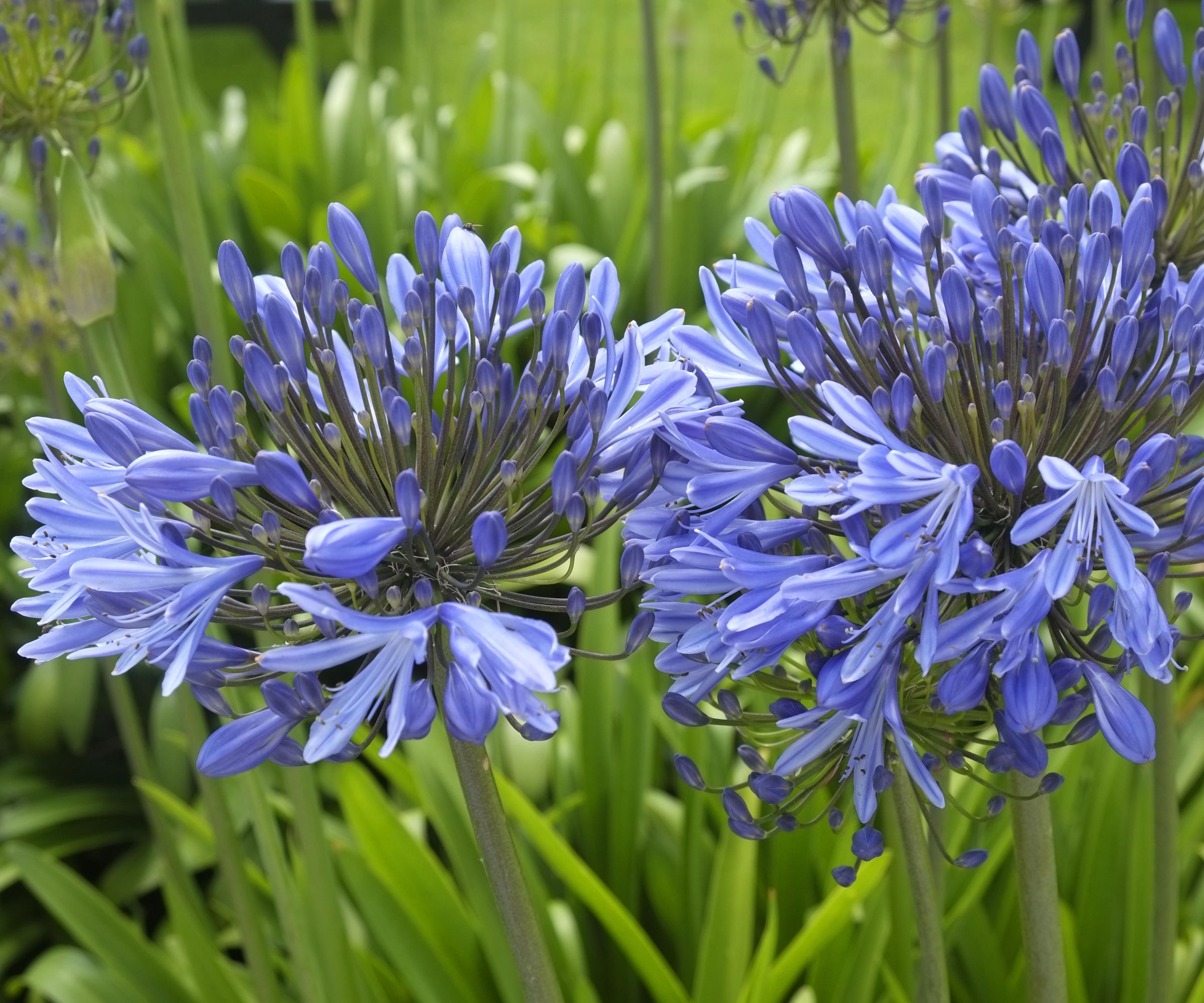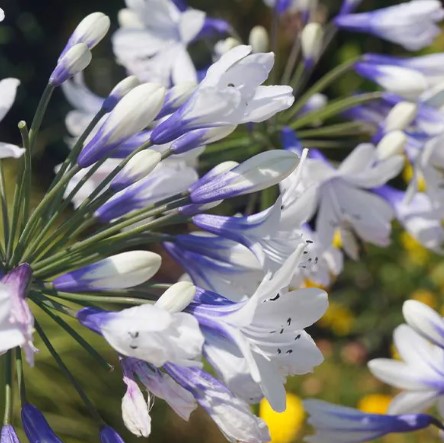How to grow agapanthus – add height and drama to your flower beds with these picture perfect pompoms
These extravagant blooms will add color and structure in one stylish bundle

Rachel Bull

Make it your mission to learn how to grow agapanthus, so you can add a touch of glamour to your backyard flower bed ideas this summer. Agapanthus blooms are such show-offs, and love being the center of attention in a border or as part of a container display.
They come in deep and dramatic inky blues and purples, as well as paler shades and pure white if you prefer things a little more on the subtle side. I've grown agapanthus in pots outside my front porch for years, and they never fail to add a fresh kerb appeal during the summer. I would definitely rate them among the best summer bulbs you can grow. A container or flower bed filled with these bursts of joy will add a touch of standout style.
Their exotic good looks (they herald from South Africa, and are also known as African lilies) suggest they might be high maintenance, but in fact they’re a breeze as long as you follow a few basics. Here is everything you need to know about growing these showy herbaceous perennials.

The best types of agapanthus to grow
There are two main types of agapanthus. Both will fair well in most US hardiness zones, but the evergreen variety requires a little more looking after.
The tough, hardy ones are known as campanula hybrids. These have narrow leaves, which they lose in winter, and are reliable plants.
They require very little looking after but will benefit from a mulch of bark chippings when they finish flowering to give them an insulating winter layer and protect them from light frost. I tend to grow this variety in the ground, in flower beds that get the most sun, and they always thrive.
Meanwhile the evergreen variety of agapanthus is more delicate, and more susceptible to cold temperatures. They do best if you grow them in containers during summer then take them indoors during winter, when a cold porch or conservatory is the ideal place for them. In the past I have put these containers in the greenhouse to overwinter, and they have faired fine.
Design expertise in your inbox – from inspiring decorating ideas and beautiful celebrity homes to practical gardening advice and shopping round-ups.
If you decide to plant rhizomes in the ground, and live in northern US hardiness zones, which experience extended freezing winters, it's recommended to dig them up in the fall, before the cold sets in, and plant them out again the following spring.
How to grow agapanthus

There are three ways to grow agapanthus. You can buy the plants in garden centers during the spring and summer – opt for those with green, healthy-looking foliage and reject anything that looks lacklustre or wilted.
Alternatively, you can plant out potted rhizomes if you want to get a head start before the summer. These thick fleshy stems have a small fan of foliage which is the growing point and should be planted with this tip pointing upwards. Buy them in containers packed with soil not loose in packaging as the root may have dried out making it less likely to flourish.
Or you can also try germinating them from seed. Whichever option you choose, with the right care will be guaranteed a gorgeous display from midsummer through to fall.
How to grow agapanthus from seed

Agapanthus are easy to grow from seed as long as you you have the space to accommodate them and the patience.
You can start flower seeds off indoors in March, in pots or trays of seed compost. It's important to find the best soil to start your seeds in, maintain a temperature of 60-68°F and keep them moist. If you live in a chillier climate, you might find the help of a heat mat, such as this great value one from Amazon, or a grow light will work wonders in getting your seedlings off to a good start.
Thin your seedlings into individual pots when they're large enough to handle, and once the root structure has developed and the final frosts have passed, they will be safe to plant out into the garden.
As an alternative to buying seed at the garden center, you can get a head start by collecting seeds at the end of summer when the seedheads turn golden and start to burst open. Store them in a paper bag and keep them somewhere dry and dark until you are ready to sow.
Where to plant agapanthus

Agapanthus love warmth, so try to choose the sunniest spot possible as you won’t get as many flowers if you plant them in the shade. Put them in a patio hotspot or plant against a warm wall and just watch myriad buds burst open, as this is a plant that loves being bathed in sunshine.
Agapanthus thrive in well-drained soil or planted in pots with plenty of added grit. Planting them in the shade or leaving them exposed to cold weather with lack of winter protection can cause problems.
Planting agapanthus in pots

If you're looking for patio planting ideas, agapanthus are a great choice. Potted up, they will add a statement touch to your patio as they produce flowers on such long stems.
Agapanthus like to be snug in their pots, so they will thrive in a closely packed container in proximity to other plants. They don’t do as well if they’re given too much space. Pack three to five rhizomes, for example, in one 14 inch diameter pot. Here's how to plant them:
- Add a layer of crocks or grit to the bottom of your pot for good drainage and set the pot on feet or bricks to keep water draining away adequately. Adding a handful of grit to your compost will also help.
- Fill the container with a soil-based compost. As you near the top, remove the plants from their pots and push the pots into the compost to create perfect planting holes.
- Remove the plastic pots from the compost and replace with the plants. Position taller plants at the back. If planting in open ground, plant lofty varieties centrally with smaller ones surrounding.
- If planting rhizomes instead of potted plants these should be covered by 2 inches of soil, with just the green tips poking out. Water several times a week for the first few months to keep the soil moist but never drench it.
- Water you plants in well. A decorative mulch is optional as your plants will soon cover the soil surface, but an organic mulch will help to retain moisture as they settle in to their new home.
- In late fall cut down all spent flower stems and fading foliage ahead of wrapping up your container for a rest over winter. Cover pots in bubble wrap and protect the crowns with a 15cm layer of straw or fleece. Replant them every two or three years to avoid them becoming pot bound.
How to care for agapanthus

Choose hardy varieties for spring planting. Just watch out for any late frosts, in which case consider wrapping them in horticultural fleece or move indoors overnight.
Water regularly during the growing season, especially in the first year. Once established they won’t need much watering. Reduce watering in winter, aiming to keep soil slightly damp.
Keep your eye on them during heatwaves or dry fall weather and water as necessary. This encourages the development of new flower buds for next year. Next year’s flowering can be poor if plants are allowed to dry out during this season.
If your agapanthus are planted in pots, feed them with a liquid all-purpose plant food, such as this Miracle Gro one from Amazon, while if they’re in a border treat them to a granular fertiliser. Feed fortnightly from April until the flowers burst open to encourage development of large flowers and lush foliage.
Shop agapanthus
FAQs
Do agapanthus come back every year?
Yes they do. Agapanthus are a perennial plant, which means once you have established your plants they will return again year-on-year, and will continue to provide exquisite color and height to your pots or beds.
if you have been inspired by these extravagant blooms, why not have a look at some more of the best summer bulbs, and see what you can plant alongside agapanthus for a joyful floral display.

Lifestyle journalist Sarah Wilson writes about garden design and landscaping trends for Homes & Gardens. She has studied introductory garden and landscape design, and also has an RHS Level 2 qualification in the Principles of Plant Growth and Development. She is a regular contributor to Homes & Gardens and Livingetc. She has also written for Country Living, Country Homes & Interiors, and Modern Gardens magazines
- Rachel BullHead of Gardens
